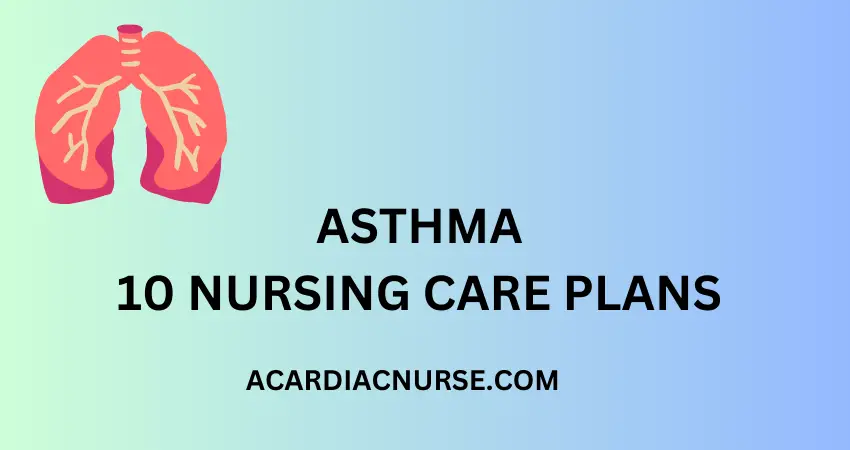10 Asthma Nursing Care Plans|Plan of Care

What is Asthma?
1. Definition:
Asthma is a long-term lung disease that causes the airways to become inflamed and narrowed. This can make it hard to breathe.
2. Symptoms:
People with asthma may experience:
- Wheezing (a whistling sound when breathing)
- Shortness of breath
- Coughing, especially at night or in the morning
- Tightness in the chest
3. Causes:
Asthma can be triggered by various factors including:
- Allergens like pollen, dust mites, and pet dander
- Respiratory infections
- Cold air or changes in weather
- Exercise
- Tobacco smoke and air pollution
4. Diagnosis:
Doctors diagnose asthma based on medical history, a physical examination, and certain tests like spirometry, which measures how well the lungs are working.
5. Treatment:
Asthma can’t be cured, but it can be managed. Treatment often includes:
- Inhalers to deliver medication directly to the lungs
- Avoiding triggers that cause asthma symptoms
- Regular check-ups with a healthcare provider
- An action plan for what to do if symptoms get worse
6. Impact:
Asthma can affect daily life and activities, but with proper management, most people with asthma can live a normal, active life.

Related Articles
Parkinson’s Disease Nursing Care Plan
What is RNC in Nursing?
Best Transport Wheelchair
RN vs. RNC
10 Nursing Diagnosis For a Patient With Asthma
1. Ineffective Airway Clearance r/t bronchoconstriction and increased mucus production AEB wheezing, coughing, and difficulty breathing
Interventions with Rationales:
- Monitor Respiratory Rate and Sounds: To detect airway blockages.
- Teach Coughing Techniques: To help clear mucus.
- Administer Prescribed Medications: Such as bronchodilators, to open airways.
- Encourage Hydration: To thin mucus.
- Use Humidifier: To soothe airways.
- Position Patient Upright: To enhance lung expansion.
- Teach Deep Breathing Exercises: To improve oxygenation.
- Provide Suctioning if Needed: To clear secretions.
- Regularly Assess Oxygen Saturation: To ensure adequate oxygenation.
- Develop an Individualized Care Plan: Based on patient’s specific needs.
Goals:
- Goal 1: Improve patient’s breathing within 24 hours.
- Goal 2: Educate patient on self-management of symptoms.
Outcome:
- The patient will maintain clear airways and demonstrate proper techniques to manage symptoms.
2. Impaired Gas Exchange r/t obstruction of airflow AEB decreased oxygen saturation, shortness of breath, and cyanosis.
Interventions with Rationales:
- Monitor Vital Signs: To detect changes in oxygenation.
- Administer Oxygen Therapy: To improve oxygen levels.
- Encourage Position Changes: To enhance lung function.
- Administer Prescribed Medications: Such as bronchodilators, to improve gas exchange.
- Teach Use of Peak Flow Meter: To monitor airflow.
- Provide Education on Smoking Cessation: If applicable, to improve lung health.
- Monitor Lab Results: Such as blood gases, to guide treatment.
- Encourage Regular Follow-Up: With healthcare providers.
- Teach Stress Reduction Techniques: Stress can worsen symptoms.
- Promote Healthy Diet: To support overall health.
Goals:
- Goal 1: Achieve and maintain optimal oxygenation levels.
- Goal 2: Equip patient with skills to manage condition at home.
Outcome:
- The patient will have stable vital signs and understand how to manage and monitor their condition.
3. Activity Intolerance r/t decreased lung function and fatigue AEB difficulty in performing daily activities and need for frequent rest.
Interventions with Rationales:
- Assess Activity Tolerance: To create a personalized exercise plan.
- Encourage Gradual Activity Increase: To build endurance.
- Provide Rest Periods: To prevent fatigue.
- Teach Energy Conservation Techniques: To maximize activity tolerance.
- Monitor Response to Activity: To ensure safety.
- Incorporate Family in Activity Plan: For support.
- Administer Medications as Needed: Such as bronchodilators before exercise.
- Provide Oxygen if Required: To support activity.
- Encourage Participation in Enjoyable Activities: To motivate the patient.
- Develop Individualized Exercise Program: With physical therapy, if needed.
Goals:
- Goal 1: Increase patient’s activity tolerance.
- Goal 2: Develop a sustainable and enjoyable exercise routine for the patient.
Outcome:
- The patient will demonstrate increased tolerance to activity without undue fatigue or respiratory distress.
4. Anxiety r/t fear of breathing difficulty and lack of control over asthma symptoms AEB verbalization of fear, increased heart rate, and restlessness.
Interventions with Rationales:
- Assess Anxiety Level: To tailor interventions.
- Teach Relaxation Techniques: Like deep breathing, to ease anxiety.
- Provide Information on Asthma Management: Knowledge reduces fear.
- Encourage Expression of Feelings: To provide emotional support.
- Involve Family in Education: For additional support.
- Create Calm Environment: To reduce stress.
- Administer Anxiety-Reducing Medications if Prescribed: For severe anxiety.
- Provide Written Materials: On asthma management.
- Encourage Participation in Support Groups: For peer support.
- Monitor Signs of Increased Anxiety: To intervene early.
Goals:
- Goal 1: Reduce patient’s anxiety level.
- Goal 2: Enhance patient’s coping abilities.
Outcome:
- The patient will report reduced anxiety and increased confidence in managing asthma.
5. Knowledge Deficit: Managing Asthma Symptoms r/t lack of prior education or understanding AEB incorrect use of inhalers, lack of awareness of triggers.
Interventions with Rationales:
- Assess Knowledge Level: To identify gaps.
- Provide Education on Asthma: Including triggers and medications.
- Demonstrate Inhaler Use: For proper technique.
- Provide Written Instructions: For future reference.
- Encourage Questions: To clarify doubts.
- Teach about Peak Flow Meter Use: To monitor airflow.
- Involve Family in Education: For support at home.
- Refer to Educational Resources: Like support groups or websites.
- Arrange Follow-Up Education Sessions: To reinforce learning.
- Customize Education to Individual Needs: For maximum effectiveness.
Goals:
- Goal 1: Increase patient’s understanding of asthma management.
- Goal 2: Improve patient’s ability to manage asthma independently.
Outcome:
- The patient will demonstrate understanding and ability to manage asthma, including proper medication use.
6. Ineffective Health Maintenance r/t lack of understanding of disease management AEB noncompliance with medication, poor follow-up with healthcare providers
Interventions with Rationales:
- Assess Lifestyle and Habits: To identify areas for improvement.
- Educate on Healthy Living: Including diet and exercise.
- Set Realistic Goals: For gradual change.
- Encourage Regular Medical Check-Ups: To monitor health.
- Provide Information on Community Resources: Like exercise classes.
- Encourage Smoking Cessation if Needed: To improve lung health.
- Collaborate with Other Healthcare Providers: For comprehensive care.
- Assist in Medication Management: To ensure proper use.
- Monitor Progress: To make necessary adjustments.
- Offer Emotional Support: To encourage positive changes.
Goals:
- Goal 1: Enhance patient’s ability to maintain overall health.
- Goal 2: Develop a personalized, sustainable health maintenance plan.
Outcome:
- The patient will demonstrate improved health habits and regular engagement with healthcare providers.
7. Risk for Allergic Response r/t exposure to known allergens AEB history of allergic reactions, presence of specific allergens in the environment.
Interventions with Rationales:
- Identify Allergens: To avoid triggers.
- Educate on Allergen Avoidance: Like using air purifiers.
- Administer Allergy Medications if Prescribed: To control reactions.
- Provide Emergency Plan: For severe reactions.
- Monitor for Signs of Allergic Reaction: To intervene quickly.
- Encourage Wearing Medical Alert Bracelet: For safety.
- Teach Proper Use of Emergency Medications: Like epinephrine.
- Encourage Regular Allergist Visits: To manage allergies.
- Provide Written Allergy Information: For reference.
- Involve Family in Allergy Management: For support.
Goals:
- Goal 1: Minimize exposure to known allergens.
- Goal 2: Equip patient with knowledge and tools to manage allergic reactions.
Outcome:
- The patient will avoid allergens and demonstrate proper action in case of allergic reaction.
8. Sleep Pattern Disturbance r/t nocturnal asthma symptoms AEB frequent awakening, reports of poor sleep quality.
Interventions with Rationales:
- Assess Sleep Patterns: To identify problems.
- Teach Good Sleep Hygiene: Like a regular sleep schedule.
- Administer Medications if Needed: To control nighttime symptoms.
- Encourage Relaxation Techniques before Bed: To promote sleep.
- Avoid Late Evening Exercise: Which may worsen symptoms.
- Provide Information on Sleep Aids if Appropriate: Like using humidifiers.
- Monitor for Sleep Apnea: A common issue in asthma patients.
- Encourage a Comfortable Sleep Environment: Like using allergen-proof bedding.
- Monitor Effectiveness of Interventions: To make necessary changes.
- Refer to Sleep Specialist if Needed: For persistent issues.
Goals:
- Goal 1: Improve sleep quality and duration.
- Goal 2: Address factors contributing to sleep disturbance.
Outcome:
- The patient will report improved sleep quality and adhere to sleep hygiene practices.
9. Fatigue r/t chronic difficulty in breathing and decreased oxygenation AEB reports of constant tiredness, lack of energy.
Interventions with Rationales:
- Assess Level of Fatigue: To tailor interventions.
- Encourage Rest Periods: To prevent overexertion.
- Teach Energy Conservation Techniques: To maximize endurance.
- Provide Nutritional Guidance: To enhance energy levels.
- Monitor Medication Side Effects: That might cause fatigue.
- Encourage Gradual Increase in Activity: To build stamina.
- Assist with Activity Planning: To balance rest and activity.
- Involve Family in Care: To provide support.
- Refer to Specialists if Needed: Like nutritionists.
- Monitor Progress: To adjust the plan as needed.
Goals:
- Goal 1: Reduce fatigue and increase energy levels.
- Goal 2: Enable patient to engage in desired activities without undue fatigue.
Outcome:
- The patient will report increased energy levels and demonstrate balance between rest and activity.
10. Chronic Pain r/t muscle strain from chronic coughing and wheezing AEB reports of chest or upper back pain, use of pain medication.
Interventions with Rationales:
- Assess Pain Level and Characteristics: To provide effective pain management.
- Administer Pain Medication as Prescribed: To control pain.
- Teach Non-Medical Pain Relief Techniques: Like heat or relaxation.
- Encourage Positioning for Comfort: To reduce pain.
- Provide Emotional Support: Pain can be distressing.
- Monitor Medication Side Effects: To minimize discomfort.
- Involve Family in Pain Management: For support.
- Refer to Pain Specialist if Needed: For chronic issues.
- Provide Written Pain Management Plan: For reference.
- Evaluate Pain Management Effectiveness: To make necessary adjustments.
Goals:
- Goal 1: Achieve pain control to patient’s satisfaction.
- Goal 2: Equip patient with strategies to manage pain at home.
Outcome:
- The patient will report reduced pain and demonstrate effective pain management techniques.
What Should a Nurse Include in Their Assessment of an Asthmatic Patient
For patients with asthma, careful and thorough assessments are essential to managing the condition effectively. Here’s a detailed guide on what a nurse should include in their assessments for asthma patients, written in a simple but comprehensive way:
1. Respiratory Assessment:
- Breath Sounds: Listen for wheezing, which is common in asthma. The presence, absence, or changes in wheezing can indicate the severity or control of asthma.
- Respiratory Rate: Monitor for an increased rate, which may be a sign of distress.
- Chest Movement: Look for symmetry and use of accessory muscles, which may indicate difficulty in breathing.
2. History Taking:
- Asthma Triggers: Identify and document known triggers such as allergens, exercise, cold air, or stress.
- Previous Asthma Attacks: Understand the frequency, severity, and treatment of previous attacks.
- Medication History: Note current medications, including inhalers, frequency, and effectiveness.
3. Physical Examination:
- Skin Assessment: Look for signs of cyanosis or pallor, which might indicate inadequate oxygenation.
- Nasal Examination: Check for nasal polyps or congestion, which can be associated with asthma.
4. Symptom Assessment:
- Cough: Note the frequency, timing, and characteristics.
- Shortness of Breath: Assess at rest and during activity, and note any patterns.
- Chest Tightness: Ask the patient to describe any feelings of chest tightness or discomfort.
5. Functional Assessment:
- Activity Tolerance: Determine how asthma affects daily activities, exercise, and sleep.
- Self-Management Skills: Assess the patient’s ability to use inhalers or other prescribed treatments correctly.
6. Diagnostic Test Review:
- Peak Flow Monitoring: Assess peak expiratory flow rates if available, to monitor lung function.
- Blood Tests: Review eosinophil counts or other relevant labs that may impact asthma management.
- Imaging: If applicable, review chest X-rays or other imaging for additional insights.
7. Psychological Assessment:
- Anxiety and Stress Levels: Since stress can be a trigger, assess the patient’s emotional state.
- Understanding of the Condition: Evaluate the patient’s understanding of asthma and its management, including an action plan for exacerbations.
8. Environmental Assessment:
- Home Environment: Discuss the home environment to identify potential allergens or triggers like smoke, dust, or pets.
10 Asthma Nursing Care Plans| Plan of Care
Asthma, a chronic inflammatory disorder of the airways, presents unique challenges that require specialized care and management.
The 10 Asthma Nursing Care Plans detailed in this guide provide a comprehensive roadmap for healthcare professionals to navigate these challenges.
These plans encompass various aspects of asthma care, from initial assessment and diagnosis to acute intervention during an exacerbation, chronic management, patient education, and emotional support.
They consider individual patient needs, asthma triggers, medication management, self-care techniques, and follow-up care.
By employing these tailored care plans, nurses can ensure consistency in practice, improve patient outcomes, and enhance the overall quality of life for those living with asthma.
Sources
Phyllis Robinson MSN, RN is a Registered Nurse of 27 years. Phyllis is passionate about the prevention and healing of heart disease using traditional and alternative methods. She has experience in emergency room, telemetry, infusion, and critical care. Phyllis currently practices in an intensive care unit.
